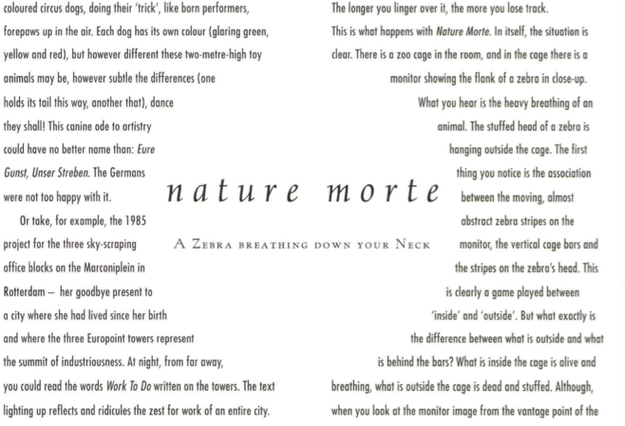What often makes art unbearable is the stuffy veil of sanctity that it is shrouded in. We all know them, those leaden altarpieces devoted to Art (by Kiefer, Beuys, Cuccbi, Kounellis), before which one must kneel and murmur softly: 'hail Europe'. A casual look at them is sacrilege. Fortunately, there will always be artists who do not give a hoot about this sacral atmosphere and determinedly desecrate Art by means of irony.
It is precisely at this ironical 'art' of reducing something to nothing by praising it to the skies that Giny Vos is particularly proficient. One of the works which clearly demonstrates this is her contribution to a travelling exhibition opened in Berlin: three brightly coloured circus dogs, doing their 'trick', like born performers, forepaws up in the air. Each dog has its own colour (glaring green, yellow and red), but however different these two-metre-high toy animals may be, however subtle the differences (one holds its tail this way, another that), dance they shall! This canine ode to artistry could have no better name than: Eure Gunsl, Unser Slreben. The Germans were not too happy with it.
Or take, for example, the 1985 project for the three sky-scraping office blocks on the Marconiplein in Rotterdam - her goodbye present to a city where she had lived since her birth and where the three Europoint towers represent the summit of industriousness. At night, from far away, you could read the words Work h Do written on the towers. The text lighting up reflects and ridicules the zest for work of an entire city. When Rotterdam lays down its head to rest after a hard day's work, its work ethics will still glow in the dark for a long time, like an immense neon sign.
Giny Vos' work can never be regarded as Art, because it simply does not belong in the world of the holy conception. We should rather see it as the work of an inventor, as a collection of inventions and finds that belong in the world of brainwave and jest. It is the pure reflection of an idea, pure in the sense that it is the most direct and effective elaboration of a find, without a trace of pretension and vanity. That is why you never get the impression that she is painfully looking for an idea, and that the material then 'imposes' that idea on her. It would rather seem as if she allows herself to be the plaything of her own brainwaves, and as if the material naturally complies with these brainwaves. Of course, she combines and arranges, and of course she has to make a decision on even the smallest detail, but such work poles into insignificance when compared to the 'work' and the effect of the room itself, of the existing situation and the secret interaction between the readymade objects that give shape to the works themselves.
The promptness with which the idea seems to materialise gives her work a deceptive transparency. A work that on first sight is as clear as glass will lose its clarity and obfuscate as soon as you become involved in the ironical game of the various components. The longer you linger over it, the more you lose track.
This is whot happens with Nature Morte. In itself, the situation is clear. There is a zoo cage in the room, and in the cage there is a monitor showing the flank of a zebra in close-up.
What you hear is the heavy breathing of an animal. The stuffed head of a zebra is banging outside the cage. The first thing you notice is the association between the moving, almost abstract zebra stripes on the monitor, the vertical cage bars and the stripes on the zebra's head. This is clearly a game played between 'inside' and 'outside'. But what exactly is the difference between what is outside ond what is behind the bars? What is inside the cage is alive and breathing, what is outside the cage is dead and stuffed. Although, when you look at the monitor image from the vantage point of the zebra's head you unmistakably feel it breathing down your neck. So is it still alive? The heavy breathing belongs to the zebra outside the cage, not the one behind bars. And by the way, is the animal on the screen really a zebra? You certainly never see all of it. It could in fact be anything. And then, is it not ridiculous to speak of an animal in a cage, when it is actually a monitor in a cage? But what is the sense of putting a monitor behind bars?
Nothing about the installation can really be trusted. It makes you feel like a school teacher who knows that as soon as he turns his back on the class, the whole caboodle will start fooling around silently. In this case, that zebra will play a dirty trick on you as soon as you look away.
Mediamatic Magazine vol 5#1+2 1 Jan 1990
Nature Morte
The Artists
A Zebra breathing down your Neck
